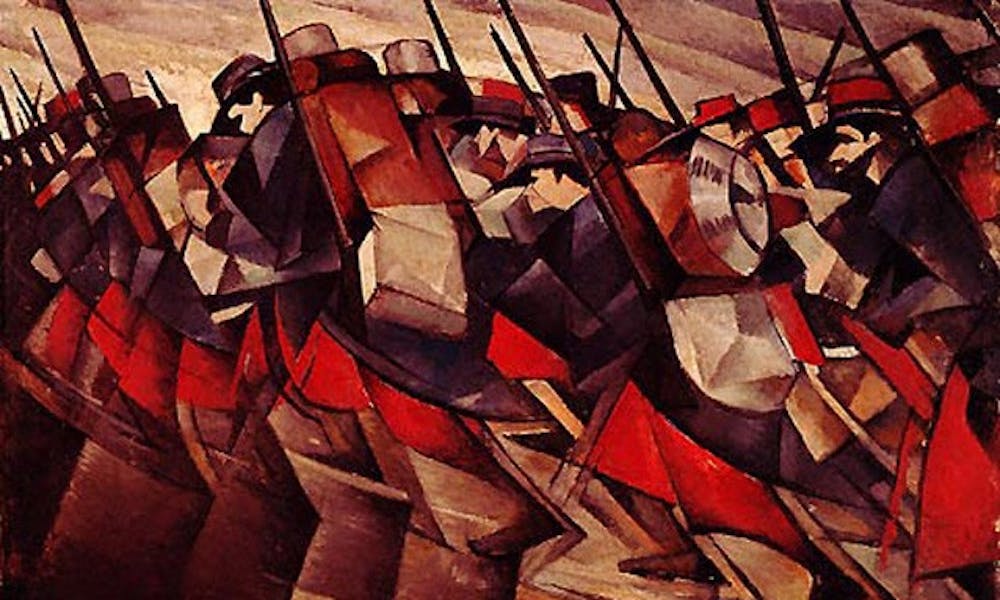Art movements often seem to be deliberately named to confuse students, with arbitrary blanket terms attempting to catchphrase something ineffable—impressionism? Suprematism? And “Dada?”
But a rare few, fortunately, remain comfortably literal. The Nasher Museum of Art’s new exhibition—The Vorticists: Rebel Artists in London and New York, 1914-1918—showcases the paintings, photographs, works on paper and sculptures of 13 artists in a movement marked and inspired by the symbolism of a vortex.
Dissatisfied with the sterility of the U.K. art scene before World War I, a group of British and American artists assembled in London to create a new, revitalizing cultural force. Declaiming themselves apart from the concurrent movements of cubism and futurism—while simultaneously borrowing much from them—the vorticists were “a concentration of energies and imaginations, the gravitation of a group of artists together with similar world views,” said Mark Antliff, co-curator and professor in the Department of Art, Art History and Visual Studies at Duke. The exhibition is also curated by Vivien Greene, curator of 19th and early 20th century art at the Guggenheim Museum in New York.
The curators drew inspiration from their own research interests and from Antliff’s graduate school studies in vorticism.
Painter and author Wyndham Lewis founded the movement along with expatriate poets such as T.S. Eliot and Ezra Pound—who were both published in the vorticist literary magazine BLAST. In it, Pound wrote, “The vortex is the point of maximum energy. It represents, in mechanics, the greatest efficiency.” In this way, vorticism shared the futurist ethos of celebrating the dynamic forces of industry and technology.
Thus, the movement appropriated the vortex as a prominent motif. In David Bomberg’s painting “The Mud Bath,” bright angles and polygons are cast radially from a central pillar. From a head buried in torso, Henri Gaudier-Brzeska’s sculpture “Red Stone Dancer” unwinds to a jaunty crouch. Alvin Langdon Coburn inserted a camera lens within a triangular tube of mirrors to capture kaleidoscopic patterns, producing “vortographs”—some of the first abstract photography.
Not only casting their works with the symbolism of vortices, the artists also saw the movement as a vortex of culture. The exhibition emphasizes the interdisciplinary nature of vorticism with its many mediums, and the movement certainly was a watershed moment for the modern literary form.
“To write poetry is to ask where it starts, and the poetry of our time begins with the avant-garde moment,” said Joseph Donahue, lecturer in the Department of English at Duke. “Vorticists and futurists made the idiom that we start with.”
Since the movement was so short-lived, there were only three vorticist exhibitions at the time—two in London and one in New York. The works displayed in the Nasher were selected to represent all three showings and to “make the argument that the movement was something that could unite the literary and artistic avant-garde in New York with that of London,” Antliff said.
Additionally, assembling the exhibition “was a process of creative discovery,” said Wendy Livingston, manager of marketing and communications at the Nasher.
During the selection process, previously unknown pencil compositions by Helen Saunders—one of the few women vorticists—were found. With this exhibition, they will be shown for the first time in almost 100 years.
For the exhibition, the Nasher is partnering with the Peggy Guggenheim Collection in Venice and the Tate Britain in London.
“This high level of collaboration certainly shows the growing professional reputation of the museum,” Livingston said.
The exhibition will be on display in the Nasher until Jan. 2, 2011. It will then move to Venice (Jan. 29 through May 15) and finally to London (June 14 through Sept. 18).
For a form that had such impact in the artistic realm, vorticism was relatively short-lived, spanning only a few years.
As Antliff emphasized, the movement was marked by an ultimate naivete toward the future and the role of progress. In 1913, sculptor Jacob Epstein mounted a humanoid machine, pregnant with child, atop a three-legged rock drill to herald a new age of humanity’s integration with technology.
As World War I—once predicted to be a swift, painless triumph of high militarism and human industry—devolved into mechanized carnage, he removed the sculpture’s drill and amputated its limbs to express his disillusionment with the machine aesthetic. War claimed too many of the movement’s central figures, and as the fighting ended, so did vorticism.
“Torso in Metal from the ‘Rock Drill’” is displayed at the exhibition’s entrance.
The Vorticists will be on display at the Nasher Museum of Art until Jan. 2, 2011. There will be an opening reception tonight at 7 p.m. featuring talks by Antliff and Greene. The Nasher is open Tuesday, Wednesday, Friday and Saturday from 10 a.m. to 5 p.m., Thursday from 10 a.m. to 9 p.m. and Sunday from noon to 5 p.m.
Get The Chronicle straight to your inbox
Signup for our weekly newsletter. Cancel at any time.

